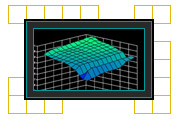| "Outsourcing
and measuring key functions is the best way to assure
high performance." |
|
-
John Roensch, CEO
|
There
are two ways to outsource video conferencing.
- Work
with a 3rd party vendor as an inside
service provider on your own video conference network
and with your own equipment.
- Work
with an outside
service provider to host video conference calls on
an external network.
There
are advantages and disadvantages to both methods of outsourcing.
Below is a brief overview of the differences between the
two:
Inside
Service Providers
- Advantages:
This is a service provided inside of your organization
by a 3rd party vendor that specializes in video conferencing
or video communications services. The highest level of
video network functioning can be expected from a well-trained
experienced team of experts managing your internal video
conferencing network.
 Many
organizations maintain their video networks with their
own small staff of skilled technicians. The usual outcome
overall is that the network suffers from "rolling
outages", a scenario of problems that perpetually
spring up at sites all throughout the video network.
Ultimately, these problems make video communications
unreliable and therefore unusable much of the time.
Even the most skilled small group of technicians managing
a network that spans an entire region or nation cannot
easily ensure all systems are "go" all the
time. Many
organizations maintain their video networks with their
own small staff of skilled technicians. The usual outcome
overall is that the network suffers from "rolling
outages", a scenario of problems that perpetually
spring up at sites all throughout the video network.
Ultimately, these problems make video communications
unreliable and therefore unusable much of the time.
Even the most skilled small group of technicians managing
a network that spans an entire region or nation cannot
easily ensure all systems are "go" all the
time.
In
order to ensure a high degree of reliability and a high
degree of security, many organizations hire a 3rd party
vendor to run their systems internally. It is reasonable
to expect 95% up time for video conference networks that
are well managed by a reputable vendor. In general, this
high degree of up time is attainable because the vendor
usually has a small team of technicians that run the network
at the customer location and a much larger team available
to dispatch globally to resolve problems. Most organizations
do not maintain such an extended staff internally.
Additionally
a high level of service and confidentiality for video
conferences is possible because the 3rd party vendor provides
services from the organization's own network and equipment.
No outside systems are used. Quality measures can be easily
monitored and reported. Technology and upgrades to systems
are the responsibility of the vendor acting within the
organization as a service provider. Costs are known and
generally constant with few surprises.
- Disadvantages:
Months may be required to enable video conferencing capability
within a large organization; this is including time required
for designing the network and installing video conferencing
equipment. Initial cost of equipment is higher than if
an outside service organization were used.
Using
conference rooms for video conferences makes sense from
a facilities perspective but this can cause video systems
to be under utilized. Normally, in an organization,
most meetings and conference room use are for local
business without a need to communicate with other facilities
or locations. Therefore, video equipment investment
can be stranded during every day normal use of conference
rooms for local meetings.
Many
organizations assign a central staff to run a video
conference network without considering the needs of
each remote site. Video conferencing requires at least
two locations, each with its own system, network, conference
or meeting room and operating instructions. Each location,
therefore, normally should have a skilled operator of
video systems to assist users in getting a conference
started and keeping it running. Few organizations are
willing to expend the funds to ensure each endpoint
is staffed with a skilled technician and so this skill
deficit can cause conference failures in some locations,
particularly those that turn systems off daily or reboot
frequently.
Industry
manufacturers understand this common problem and are
providing software tools and remote management capability
with the latest video conference equipment to allow
for remote management of systems. Therefore, a well-run
network requires either skilled personnel at each endpoint
or some form of remote management in order to ensure
systems operate well. Some combination of both is usually
required to attain high levels of video network up time.
Outside Service Providers
- Advantages:
This involves rental of rooms and facilities that are
owned and maintained by a 3rd party or an "outside
vendor". At its best, this type of vendor provided
outsourcing allows a customer to walk in, sit down and
meet visually across the globe without major capital investment.
The service provider will provide all network connections,
video conference systems, billing and helpdesk support.
This can be a highly convenient way to use video communications
for a geographically distributed organization.
 Additionally,
it is the service provider's responsibility to maintain
meeting rooms all around the world or to maintain its
own rental agreements with many vendors that provide
such facilities. New technology and upgrades to systems
are the responsibility of the service provider and their
affiliates. Therefore, an organization that uses an
outside service provider for video conferencing can
be free of the many infrastructure, personnel and training
issues that are required to install, maintain and operate
a video communications network. Additionally,
it is the service provider's responsibility to maintain
meeting rooms all around the world or to maintain its
own rental agreements with many vendors that provide
such facilities. New technology and upgrades to systems
are the responsibility of the service provider and their
affiliates. Therefore, an organization that uses an
outside service provider for video conferencing can
be free of the many infrastructure, personnel and training
issues that are required to install, maintain and operate
a video communications network.
- Disadvantages:
Low level of convenience in meeting times and locations.
Rental rooms are often scheduled back-to-back by the outside
vendor. Vendors maximize the utilization of the video
conference equipment and therefore the focus of the service
is not on increasing customer productivity but instead
on increasing the productivity of the vendor's video equipment.
Additionally, the outside vendor manages all the factors
associated with video communications pricing and costs.
About
TKO
TKO Video Communications provides outsourcing, equipment
(Sony, Tandberg, Cisco Systems, Radvision, Polycom, Initia
AccessSwitch), services and technical support for global
video conferencing networks. We distinguish ourselves from
all vendors in the video communications industry by providing
high quality video conference outsourcing, video solutions
and products with unparalleled attention to our client's
objectives.
Sony
| Tandberg
| 550
| 880
| 1000
| 7000
| MCU
| Codec
| Monitors
Webex
| Forgent
| System
| Conference
Tables | Cart
| Polycom
|